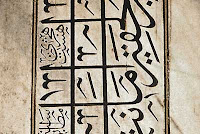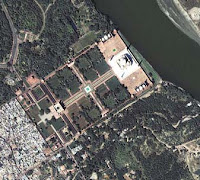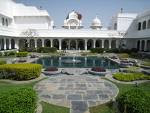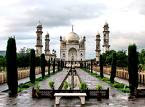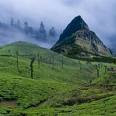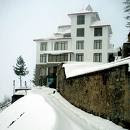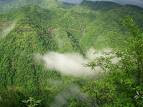Introduction to The Taj Mahal
The Taj Mahal is arguably one of the most incredible manmade constructions in the world. It’s located in Agra, which is in the north central part of Indian, on the right part of the Humana River. Known for its symmetry, the Taj Mahal sits on a raised platform surrounded by four minarets. Inside are delicate mosaic works and marble walls decorated with intricate patterns of inlaid precious stones. The Taj seems to glow in the light of the full moon. On a foggy morning, the visitors experience the Taj as if suspended when viewed from across the Jamuna river.Taj Mahal Facts
The Taj Mahal is a mausoleum (a large tomb). It was commissioned by Mughal Emperor Shah Jahan for his favourite wife Empress Mumtaz Mahal, who died in 1631. So great was the Shah Jahan’s love for his wife Mumtaz, that he ordered the building of the most beautiful mausoleum on Earth for her, The Taj Mahal.
Emperor Shah Jahan Empress Mumtaz Mahal

* The construction documents show that its master architect was Ustad ‘Isa, the renowned Islamic architect of his time.
* The Taj stands on a raised, square platform (186 x 186 feet) with its four corners truncated, forming an unequal octagon. The architectural design uses the interlocking arabesque concept, in which each element stands on its own and perfectly integrates with the main structure.
* The tomb stands on its own marble base, which rests on a red sandstone platform. Four tall pillars, 138 ft each, rise up from the corners of the white marble base are topped with eight windowed cupolas. This has been made to replicate throne of God in paradise. Directly below the dome rests Mumtaz Mahal’s tomb, which is centrally lined with the main entrance. Besides Mumtaz Mahal’s tomb is the tomb of Shahjahan. The tomb of Shahjahan was not actually intended to be there but Aurangzeb placed it there, consequently breaking the symmetry.
- The Taj Mahal is generally considered the finest example of Mughal architecture, a style that combines elements of Persian, Turkish, Indian, and Islamic architectural styles.
- Construction of the tomb started in 1632, and was completed in 1648. It took 22 years to complete the tomb, and an extra 5 years for the garden, with the help of 20,000 workers. Sculptors, masons, craftsmen, and calligraphers were called from Persia, Ottoman Empire and Europe to work on construction of the Taj.
- The Taj Mahal is built from precious white marbel with dedlicate masiac, with inlaid precious stones. Almost every surface of the entire building has been decorated, and every detail is symmetrical. The mosaic designs are based on three decorative elements- calligrapyh, abtract geonetric and vegetative motifs. The exterior decorations of the Taj Mahal are among the finest to be found in Mughal architecture of any period.
Inside the dome
Calligraphy:
Mosaic:
- The Taj Mahal cost 32million rupees to build, which is roughly $1,000,000.
- The tomb initially called “Rauza”. Later, after Mumtaz Mahal passed away, the mausoleum would be called the Taj Mahal, a derivative of the name Mumtaz Mahal.
- The architectural complex of the Taj Mahal comprises of five main elements: the Darwaza or main gateway, the Bageecha or garden, the Masjid or mosque, the Naqqar Khana or rest house, and the Rauza or the Taj Mahal mausoleum.
- The name Taj Mahal when translated means “Crown Palace” or “Crown of the Palace.”
- The Taj Mahal is one of the eight wonders of the world.
Taj Mahal Myths
The Taj Mahal comes attached with many myths and legends; whilst many are strongly believed, others are laughed at. There is evidence to suggest that these rumours are based on truth, but nothing is set in stone.
- Many people believe, Shah Jehan had planned to build another Taj Mahal in black marble, which was to be his own tomb on the opposite bank of the River Yamuna and connect the two by a bridge. However, the construction never got started due to conflict with this son’s, which took up most of his time.
- Shah Jehan deemed that no one else should ever copy the masterpice, so he had the master craftsmans hands cut off.
Some European scholars held the view that the Taj was designed by an Italian – Geronimo Veroneo. This was first suggested by Father Manrique, an Augustinian Friar, who came to Agra in 1640 A.D. to secure the release of Father Antony who had been imprisoned by the Mughals.
- In the early years after the Taj Mahal was built, a long series of cracks in the underground vaults started to emerge. Those cracks were quickly seen to, and patched up. Cracking has been observed at different times since construction; testing in the early 19th Century showed the base of the mausoleum on the northern side of the structure is lower than on the south by 3.5 centimetres. There is some evidence the Taj Mahal is gradually sinking into the Yamuna River.
Taj Mahal Front View
Taj Mahal Birdseye View
Taj Mahal Dome Exterior
Location: On the banks of river Yamuna in Agra, India.
Year of Construction: 1631-1653
Built By: Mughal Emperor Shah Jahan
Built For: In memory of the Emperor’s dead wife
Spread Over: 42 acres
Significance: One of the Seven Wonders of the World





